
The French Wars of Religion refers to the period of civil war between French Catholics and Protestants from 1562 to 1598. Between two and four million people died from violence, famine or disease directly caused by the conflict, and it severely damaged the power of the French monarchy. One of its most notorious episodes was the St. Bartholomew's Day massacre in 1572. The fighting ended with a compromise in 1598, when Henry of Navarre, who had converted to Catholicism in 1593, was proclaimed King Henry IV of France and issued the Edict of Nantes, which granted substantial rights and freedoms to the Huguenots. However, Catholics continued to disapprove of Protestants and of Henry, and his assassination in 1610 triggered a fresh round of Huguenot rebellions in the 1620s.

Gaspard de Coligny, seigneur de Châtillon, was a French nobleman, Admiral of France, and Huguenot leader during the French Wars of Religion. He served under kings Francis I and Henry II during the Italian Wars, attaining great prominence both due to his military skill and his relationship with his uncle, the king's favourite Anne de Montmorency. During the reign of Francis II he converted to Protestantism, becoming a leading noble advocate for the Reformation during the early reign of Charles IX.
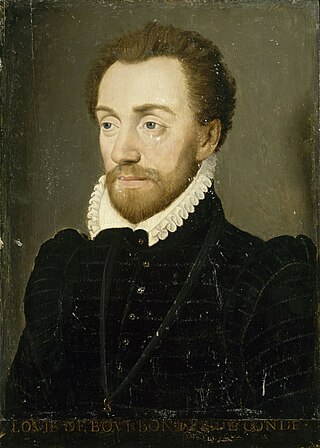
Louis de Bourbon, 1st Prince of Condé was a prominent Huguenot leader and general, the founder of the Condé branch of the House of Bourbon. Coming from a position of relative political unimportance during the reign of Henri II, Condé's support for the Huguenots, along with his leading role in the conspiracy of Amboise and its aftermath, pushed him to the centre of French politics. Arrested during the reign of Francis II then released upon the latter's premature death, he would lead the Huguenot forces in the first three civil wars of the French Wars of Religion before being executed after his defeat at the Battle of Jarnac in 1569.

Jacques de Savoie, duc de Nemours was a French military commander, governor and Prince Étranger. Having inherited his titles at a young age, Nemours fought for king Henri II during the latter Italian Wars, seeing action at the siege of Metz and the stunning victories of Renty and Calais in 1554 and 1558. Already a commander of French infantry, he received promotion to commander of the light cavalry after the capture of Calais in 1558. A year prior he had accompanied François, Duke of Guise on his entry into Italy, as much for the purpose of campaigning as to escape the king's cousin Antoine of Navarre who was threatening to kill him for his extra-marital pursuit of Navarre's cousin.
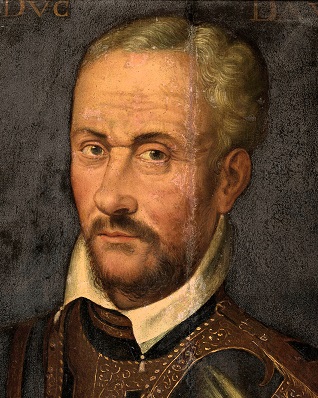
Claude II de Lorraine, duc d'Aumale was a Prince étranger, military commander and French governor, during the latter Italian Wars and the early French Wars of Religion. The son of the first Duke of Guise he started his career in a pre-eminent position in French politics as a son of one of the leading families in the court of Henri II of France. Upon the death of his father in 1550, Aumale inherited the governorship of Burgundy from his father, and the duchy of Aumale from his brother who assumed the titles of Guise. Aumale was made colonel-general of the light horse by the new king and fought in Italy, Alsace and Picardie between 1551 and 1559. While leading the light cavalry during the defence of Metz he was captured, and held for the next two years, until his mother in law Diane de Poitiers paid his ransom. He achieved success at the siege of Volpiano and played an important role in the capture of Calais for which he was rewarded with the governorship of French Piedmont.
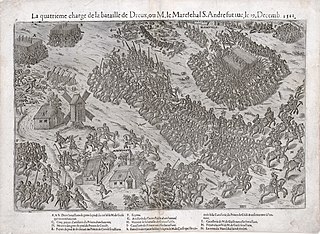
The Battle of Dreux was fought on 19 December 1562 between Catholics and Huguenots. The Catholics were led by Anne de Montmorency while Louis I, Prince of Condé, led the Huguenots. Though commanders from both sides were captured, the French Catholics won the battle which would constitute the first major engagement of the French Wars of Religion.

The Peace of Saint-Germain-en-Laye was signed on 8 August 1570 by Charles IX of France, Gaspard II de Coligny and Jeanne d'Albret, and ended the 1568 to 1570 Third Civil War, part of the French Wars of Religion.

The Battle of Saint-Denis was fought on 10 November 1567 between a Royalist army and Huguenot rebels during the second of the French Wars of Religion. Although their 74 year old commander, Anne de Montmorency, was killed in the fighting, the Royalists forced the rebels to withdraw, allowing them to claim victory.

Sébastien de Luxembourg, viscomte de Martigues (1530-1569) was a French military officer, peer of France and governor of Brittany. Martigues began his political career serving under his uncle Étampes the governor of Brittany as the lieutenant-general of the province. He gained the office of colonel-general of the French infantry after the prior office holder died at the siege of Rouen during the first war of religion. In this important military role he played a key part in the royal victory at the Battle of Dreux, the main battle of the first of the French Wars of Religion. In 1565 on the death of his uncle, he gained both the governorship of Brittany and the county of Penthièvre which was subsequently elevated to a dukedom.

Gaspard de Saulx, sieur de Tavannes was a French Roman Catholic military leader during the Italian Wars and the French Wars of Religion. He served under four kings during his career, participating in the Siege of Calais (1558) and leading the royal army to victory in the third civil war at the Jarnac and Moncontour. A strong Catholic, he founded the confraternity of the holy ghost in 1567 which would be a template for other militant Catholic organisations across France. He died in 1573, shortly after the opening assassinations of the Massacre of Saint Bartholomew, which he had helped plan.
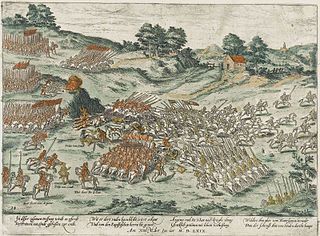
The Battle of Jarnac on 13 March 1569 was an encounter during the French Wars of Religion between the Catholic forces of Marshal Gaspard de Saulx, sieur de Tavannes, and the Huguenots led by Louis I de Bourbon, prince de Condé. The two forces met outside Jarnac between the right bank of the Charente and the high road between Angoulême and Cognac. The Huguenots were routed and Condé was killed after his surrender and his body paraded on an ass in Jarnac.
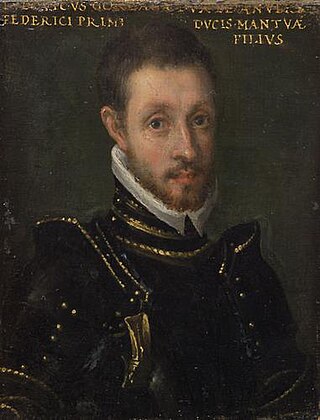
Louis de Gonzague, Duke of Nevers was a soldier, governor and statesman during the French Wars of Religion. His father and brother were reigning dukes of Mantua. He came to France in 1549, and fought for Henri II of France during the latter Italian Wars, getting himself captured during the battle of Saint Quentin. Due to his Italian connections he was seen as a useful figure to have as governor of French Piedmont, a post he would hold until Henri III ceded the territory in 1574. In 1565 his patron, Catherine de' Medici secured for him a marriage with the key heiress Henriette de Clèves, elevating him to duke of Nevers and count of Rethel. He fought for the crown through the early wars of religion, receiving a bad injury in the third war. At this time he formed a close bond with the young Anjou, future king Henri III, a bond that would last until the king's death.
The Battle of La Roche-l'Abeille occurred on 25 June 1569 between the Catholic forces of King Charles IX of France commanded by the Duke d’Anjou and the Huguenots commanded by the Admiral de Coligny during the "Third War" (1568–1570) of the French Wars of Religion.
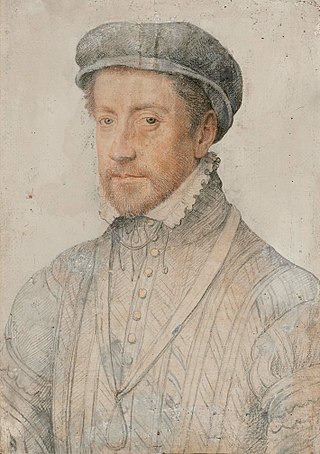
Louis de Bourbon, Duc de Montpensier was the second Duke of Montpensier, a French Prince of the Blood, military commander and governor. He began his military career during the Italian Wars, and in 1557 was captured after the disastrous battle of Saint-Quentin. His liberty restored he found himself courted by the new regime as it sought to steady itself and isolate its opponents in the wake of the Conspiracy of Amboise. At this time Montpensier supported liberalising religious reform, as typified by the Edict of Amboise he was present for the creation of.

Albert de Gondi, duc de Retz seigneur du Perron, comte, then marquis de Belle-Isle (1573), duc de Retz, was a marshal of France and a member of the Gondi family. Beginning his career during the Italian Wars he fought at the Battle of Renty in 1554, and in many of the campaigns into Italy in the following years, before returning to France for the disastrous battle of Saint-Quentin and battle of Gravelines both of which saw the French army savaged.
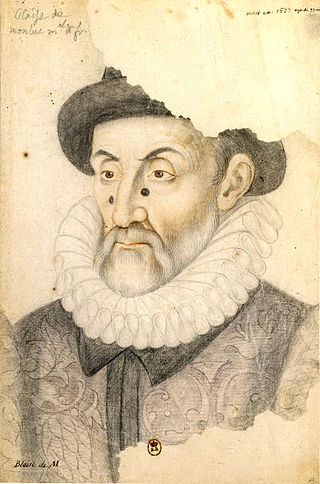
The Battle of Vergt took place on 9 October 1562 in the early stages of the French Wars of Religion, between a Royalist army led by Blaise de Montluc and Huguenot rebels under Symphorien de Duras. The battle was a decisive Royalist victory, which destroyed Duras' army, and prevented him reinforcing Protestant forces in the Loire Valley led by Gaspard II de Coligny and Condé. As such, it is considered a turning point in the first French War of Religion.

The siege of Poitiers was a siege of the French city of Poitiers in summer 1569 as part of the French Wars of Religion. By that time the city was a Catholic stronghold faithful to Charles IX of France, though Jean Calvin had preached there in 1534 and it had taken the Protestant side from May to July 1563 before being recaptured by the Catholic Royalist party.

The assassination of Admiral Coligny on 24 August 1572 would prelude one of the critical events of the French Wars of Religion, the Massacre of Saint Bartholomew. The figures responsible for first the attempt on his life on 22 August and then his execution on 24 August have long been debated by historians. Coligny's feud with Henry I, Duke of Guise throughout the 1560s and his desire to bring France into conflict with Spain are often cited as key factors. The attempt on his life took place in the wake of the marriage between Navarre and Margaret of Valois a high-profile affair intended as a component of the Peace of Saint-Germain-en-Laye by Catherine de'Medici and her son Charles IX
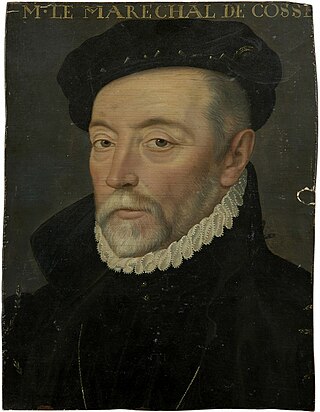
Artus de Cossé, seigneur de Gonnor and Comte de Secondigny (1512–1582), was a Marshal of France, an office he was elevated to in 1567. He served to administer the armies finances during the first of the French Wars of Religion and would lead the royal army in its pursuit of the Prince of Condé during the second civil war. His failure to catch the army led to his dismissal from overall royal command. During the third civil war he would again lead troops, beating a small Protestant force, before being defeated in the final days of the war at Arney-le-Duc. His long history of Politique leanings would push him into the orbit of the Malcontents for which he would be arrested in 1574. In 1576 he would be released and restored to favour before he died in 1582.
Laurent de Maugiron, comte de Montléans was a French military commander and lieutenant-general of Dauphiné during the Italian Wars and French Wars of Religion. Beginning his career during the reign of Henri II he fought at the defence of Metz in 1552, and in the Picardie campaign of 1554. With peace declared in 1559, he returned to Dauphiné, where he worked with the lieutenant-general La Motte Gondrin, in his attempts to stamp out Protestantism in the region.


















